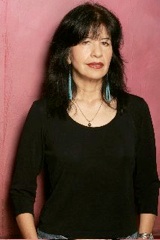This is a report by tribal arts observer, William Ernest Waites, publisher of Tribal Artery, on his impressions of SWAIA Santa Fe Indian Market 2008~~~~~~~~~~~~~~~~~~~~~~~~~~~~~~~Many aspects of this year's Santa Fe Indian Market were improvements over previous years. Some seemed to be a step backward. And many were business as usual, stuck in a tradition that is due for some changes, in my opinion.
First, the improvements. The crowds seemed to be smaller, both at the Friday night preview and the market streets per se. Granted, this is not all good news. Smaller crowds mean lower demand and many artists were feeling the pressure of lower sales. Exacerbating this and may be even part of the cause were economic conditions that have a lot of people worried, whether for cause or psychologically. It doesn't matter for the artist. When the wallets don't open, the artists suffer.
At least one well-known artist, who usually sells out by 10:00 AM, had a booth full of pieces when we walked by shortly before noon on Saturday. Other artists commented that things were slower as evidenced by tables filled with unsold work.
Of course the standard answer when you ask an artist , “How's it going?' is, “It's great!” So take my observations and add those evaluations, then stir with a dash of skepticism and a spoonful of optimism.
At the preview, apparently, there was a change in policy. The number of press passes was reduced, meaning that many media people who might normally attend and report on the event were not present for the awards announcement. Many of the writers and photographers from the press had to compete with the special guests and VIPs that were admitted to the preview at the same time.
(Ironically, because it was difficult for the Executive director of SWAIA to contact the Best of Show winner, the announcement had to wait for the artist to appear anyway.)
What do I consider a step backward?
As a matter of admitted self-interest, as one who was unable to enter at the preview room before the crowd, I felt like I was being discriminated against. I'm sure there were others who shared that feeling.
I don't think it is advantageous for SWAIA, especially in a year when the economy seems to be working against maximum success, to limit exposure of the event and news about it. The media, all the media, should be encouraged so that the news gets out quickly to those who are interested but unable to attend in person.
Many of those people do not read the local newspapers or watch the local TV stations. They are spread around the world. SWAIA needs to recognize that the web and the internet are the way many of these people get their information about tribal art. Ignoring or discounting the web as a way of disseminating information misses the fastest way to make your story accessible to the public. It also misses the opportunity to archive information for consumers who aren't paying attention when the news hits.
As for being stuck in tradition, it is time, in my opinion, for SWAIA to recognize that there are significant differences between a 4-inch high fetish carving and a 4-foot high marble sculpture. To keep them in the same judging category is unfair or, at least, inappropriate,. It's not as if new categories could not be created. Thes new categories could increase the number of opportunities for artists who decline to enter in categories that they feel may be stacked against them. The same thing can be said about the differences between stone sculpture and glass blowing, between painting and photography, between bead work and quill work, and between textiles and basketry.
I am particularly concerned about the discrepancy between fetish carving and sculpture. There is no rational reason for keeping both kinds of work in the same category when two categories could be created. The only possible rationale, to my view, would be that it makes it easier for SWAIA to organize . I have found when organizations focus on what is easier forthem rather than what is best for their clientele, they are looking through the wrong end of the telescope.
I'm told there are other interested parties with affinity for the little fetish gems, who share my concern. We should get together and give SWAIA the benefit of our thinking. Perhaps this blog can be a start. If you agree with this point of view, please give this blog a comment.
About the winners themselves. Of course, judging is subjective. I felt, however, that many of the lesser ribbons, the second-place and third-place winners, were more deserving than some of the entries that won first place.
Oh well! That's what makes horse races, and art competitions.
I'm including photographs of the Best of Show and Best of Classification, as best I was able to photograph them under the preview conditions.

Best of Show and
Best of Classification III. Painting - Sheldon Harvey

Best of Classification I. Jewelry - Rebecca Begay

Best of Classification II. Pottery - Linda Tafoya-Sanchez

Best of Classification IV. Wooden Pueblo Carving - Robert Albert

Best of Classification V. Sculpture - Sheldon Harvey

Best of Classification VI. Textiles & Basketry - Mona Laughing

Best of Classification VII. Diverse Arts - Jamie Okuma

Best of Classification VIII. Quillwork & Beadwork - Juanita & Jessica Growing Thunder

Best of Classification IX. Youth - Trent Lee






























